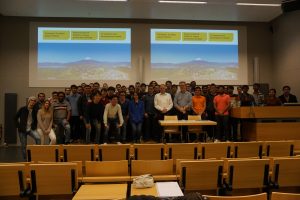Schlagwort: ‘Roboterprogrammierung’
IGMR Seminar 26.01.2021: Robert Grafe, Deutsches Rettungsrobotik-Zentrum e.V.
Unbemannte Systeme in der Gefahrenabwehr, der Aufbau des Deutsches Rettungsrobotik-Zentrums.
https://youtu.be/anZtJAajQy0
Wir begrüßen Herrn Grafe vom DRZ zum IGMR Seminar. Auch dieser Veranstaltung wird weiterhin virtuell durchgeführt:
Unbemannte Systeme in der Gefahrenabwehr, der Aufbau des Deutsches Rettungsrobotik-Zentrums Die Nutzung unbemannter, bodengebundener Systeme bietet großes Potential, Einsatzkräfte von Hilfsorganisationen und Feuerwehren bei besonders gefährlichen oder zeitraubenden Einsätzen zu unterstützen. Auf Grund der anspruchsvollen Aufgaben und Szenarien ist der Sprung von der Forschung in die reale Nutzung jedoch bisher nur vereinzelt geglückt. Der Vortrag stellt diesen Stand von Forschung und Entwicklung dar und beschreibt den Ansatz, welcher mit der Gründung des Deutschen Rettungsrobotik-Zentrums beschritten wird, um die Realisierung von praxis-/ und produktnahen Lösungen zu fördern.
Dienstag, 26. Januar 2021 16:30 Uhr in Zoom
Zoom Meeting Informationen:
https://rwth.zoom.us/j/98454895570?pwd=NkpiSWkyaTJtdWlralJrSUtnMDdDZz09
Meeting-ID: 984 5489 5570
Kenncode: 186393
Die Datenschutzhinweise zur Nutzung von Zoom und eine Handreichung für Teilnehmer (Studierende) können von den Seiten des CLS der RWTH Aachen University heruntergeladen werden.
Die Veranstaltungen im Wintersemester 2020/2021 werden in Zusammenarbeit mit dem VDI-GPP-Arbeitskreis des Bezirksvereins Aachen durchgeführt.
Weitere Informationen können auch dem Blog-Beitrag IGMR als Mitglied des Deutsches Rettungsrobotikzentrum e.V entnommen werden.
Ansprechpartner:
TCP and null space impedance for bypassing objects with the KUKA iiwa
In the video two different types of impedance control of the KUKA iiwa are shown: TCP and null space impedance. Furthermore, the bypassing of objects using impedance control has been implemented.
https://youtu.be/VHrV-nh5oTU
First, the two different types of impedance control are demonstrated. Different stiffnesses can be programmed around the individual TCP axes. Two different stiffnesses within a plane are shown in the video. On the other hand, there is null space impedance. In this case, the robot maintains the pose of the TCP and the elbow can be pushed away. As shown in the video, this can be used to bypass an object while maintaining the programmed TCP path.
Project page: NextGeneration
Contacts:
IGMR Seminar: Mr. Ramsden – Fanuc Europe

Archivbild
Auch in diesem Jahr begrüßen wir Mr. Ramsden von Fanuc für ein IGMR Seminar. In diesem Jahr wird das Seminar leider virtuell stattfinden.
Zum dritten Mal in diesem Jahr dürfen wir Mr. Ramsden im IGMR Seminar begrüßen. Wie in jedem Jahr ist das Seminar auch als Gastvorlesung in das Modul Robotic Systems an der RWTH eingebunden. Mr. Ramsden wird in zwei Teilen wieder einen spannenden Einblick in Produkte von Fanuc bieten.
Die Veranstaltungen im Wintersemester 2020/2021 werden in Zusammenarbeit mit dem VDI-GPP-Arbeitskreis des Bezirksvereins Aachen durchgeführt.
Seminartermine:
Montag, 14. Dezember 2020 14:30 Uhr per Zoom
Donnerstag, 17. Dezember 2020 16:30 Uhr per Zoom
Zoom Meeting Informationen:
https://rwth.zoom.us/j/98454895570?pwd=NkpiSWkyaTJtdWlralJrSUtnMDdDZz09
Meeting-ID: 984 5489 5570
Kenncode: 186393
Die Datenschutzhinweise zur Nutzung von Zoom und eine Handreichung für Teilnehmer (Studierende) können von den Seiten des CLS der RWTH Aachen University heruntergeladen werden.
Ansprechpartner:
Haptic feedback system RePlaLink
At IGMR, the haptic feedback system RePlaLink (Reconfigurable Planar Linkage) is being developed. With this system, hand-actuated mechanisms can be haptically simulated and interactively synthesized. Furthermore, users can interactively synthesize these mechanisms. This should allow mechanisms with optimal haptic properties to be developed.
People frequently interact with hand-actuated mechanisms in everyday life, e.g., in car doors, furniture doors, reconfigurable furniture, or fitness equipment. Their haptic properties largely determine the perceived quality of these mechanisms. The RePlaLink (Reconfigurable Planar Linkage) aims to support the design and development of these mechanisms by applying haptic feedback systems based on virtual prototypes. The haptic simulation and synthesis method allows users to directly feel mechanisms’ kinematic and kinetostatic properties while operating the system. In addition, users can interactively modify these properties and receive direct haptic feedback. In the first video, the design of the RePlaLink, consisting of a planar five-link with an additional serial link for the handle, is shown.
https://youtu.be/pemrysX4Cr8
The second video shows haptic simulation and synthesis using a kitchen cabinet door as an example.
https://youtu.be/0AqONOv1R5E
Project page:
https://www.igmr.rwth-aachen.de/index.php/de/gt/gt-replalink
Contact:
Mahshid Pour Ebrahimabadi M.Sc.
Teaching the KUKA iiwa by manual guidance
The hand guidance of the collaborative robot KUKA iiwa is well suited for programming spatial points. This is possible both within a program and in the robot’s T1 mode.
https://youtu.be/v7D4yknlxJI
The video shows the manual guidance of the KUKA iiwa within a program. The robot can be guided by hand on the flange when the user presses the gray consent button. After releasing it, the program asks whether the current position is correct and should be saved. Any number of additional positions can then be added. At the end of the program, all stored room points are traversed in the taught sequence.
Contacts:



